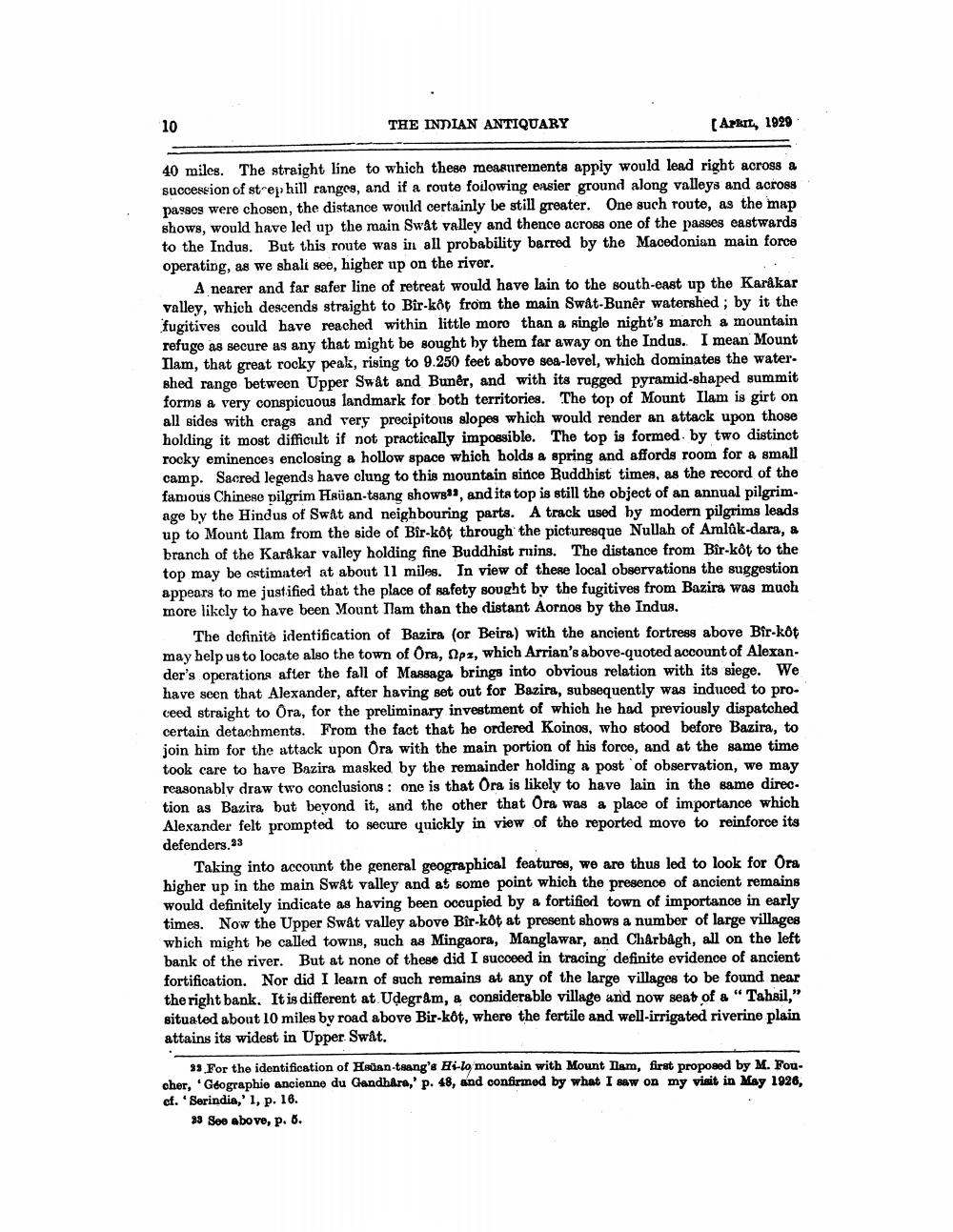________________
THE INDIAN ANTIQUARY
(Arkit, 1929
40 miles. The straight line to which these measurements apply would lead right across a succession of strephill ranges, and if a route foilowing easier ground along valleys and across passes were chosen, the distance would certainly be still greater. One such route, as the map shows, would have led up the main Swat valley and thence across one of the passes eastwards to the Indus. But this route was in all probability barred by the Macedonian main force operating, as we shali see, higher up on the river.
A nearer and far safer line of retreat would have lain to the south-east up the Karåkar valley, which descends straight to Bir-kôt from the main Swat-Bunêr watershed; by it the fugitives could have reached within little more than a single night's march a mountain refuge as secure us any that might be sought by them far away on the Indus. I mean Mount Ilam, that great rocky peak, rising to 9.250 feet above sea-level, which dominates the water. Bhed range between Upper Swat and Buner, and with its rugged pyramid-shaped summit forms a very conspicuous landmark for both territories. The top of Mount Ilam is girt on all sides with crags and very precipitous slopes which would render an attack upon those holding it most difficult if not practically impossible. The top is formed by two distinct rocky eminences enclosing a hollow space which holds a spring and affords room for a small camp. Sacred legends have clung to this mountain since Buddhist times, as the record of the famous Chinese pilgrim Hsuan-tsang showg8, and its top is still the object of an annual pilgrimage by the Hindus of SwAt and neighbouring parts. A track used by modern pilgrims leads up to Mount Ilam from the side of Bir-kôt through the picturesque Nullah of Amlak-dara, a branch of the Karåkar valley holding fine Buddhist ruins. The distance from Bir-kôt to the top may be estimated at about 11 miles. In view of these local observations the suggestion appears to me justified that the place of safety sought by the fugitives from Bazira was much more likely to have been Mount Ilam than the distant Aornos by the Indus.
The definite identification of Bazira (or Beira) with the ancient fortress above Bir-kot may help us to locate also the town of Ora, Apz, which Arrian's above-quoted account of Alexander's operations after the fall of Massaga brings into obvious relation with its siege. We have seen that Alexander, after having set out for Bazira, subsequently was induced to proceed straight to Ora, for the preliminary investment of which he had previously dispatched certain detachments. From the fact that he ordered Koinos, who stood before Bazira, to join him for the attack upon Ora with the main portion of his force, and at the same time took care to have Bazira masked by the remainder holding a post of observation, we may reasonably draw two conclusions: one is that Ora is likely to have lain in the same direc. tion as Bazira but beyond it, and the other that Ora was a place of importance which Alexander felt prompted to secure quickly in view of the reported move to reinforce its defenders.23
Taking into account the general geographical features, we are thus led to look for Ora higher up in the main Swat valley and at some point which the presence of ancient remains would definitely indicate as having been occupied by a fortified town of importance in early times. Now the Upper Swât valley above Bir-kot at present shows a number of large villages which might be called towns, such as Mingaora, Manglawar, and Charbagh, all on the left bank of the river. But at none of these did I succeed in tracing definite evidence of ancient fortification. Nor did I learn of such remains at any of the large villages to be found near the right bank. It is different at Udegram, a considerable village and now seat of a "Tahsil," situated about 10 miles by road above Bir-kot, where the fertile and well-irrigated riverine plain attains its widest in Upper Swât.
39 For the identification of Haan taang's Hi-lo mountain with Mount Tam, first proposed by M. Foucher, 'Géographie ancienne du Clandhara,' p. 48, and confirmed by what I saw on my visit in May 1926, ef. Serindia,' 1, p. 16.
93 See above, p. 6.




